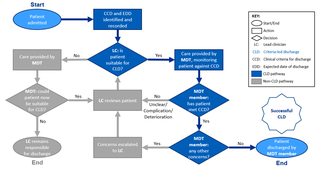Rapid improvement guide to criteria-led discharge
Improving patient flow and bed capacity is a global issue.
Criteria-led discharge (CLD) enables some patient discharges to be accelerated in accordance with patient selection. In a systematic review of criteria-led patient discharges, it showed no increase in patient readmission or complication rates with criteria-led discharge, demonstrating patient safety. The studies did not show an increase in length of stay.
Criteria-led discharge is the use of agreed clinical criteria and their related clinical parameters to guide clinical decisions regarding patient discharge from hospital. It enables a range of registered healthcare practitioners (HCPs) to lead a patient’s discharge and makes the clinical discharge plan transparent to the entire multidisciplinary team caring for the patient. Criteria-led discharge will work best with morning ward rounds and proactive decision making.
The senior clinical decision maker identifies the clinical criteria for discharge (CCD). The CCD are discussed with the patient and multi-disciplinary team (MDT) and used to identify the expected date of discharge (EDD), all of which is clearly recorded in the patient’s notes. If there are no complications or concerns, a competent member of the MDT discharges the patient when the CCD are met.

Approaches to criteria-led discharge
The approach taken will depend on the type of clinical setting and type of patient discharge: simple, intermediate, or complex. Two approaches are generally practised:
- Specific criteria are developed from an existing clinical protocol/guideline for a specific patient condition, such as cellulitis or laparoscopic surgery. This approach usually applies to elective patient admissions. Generally, specific criteria are used for simpler discharges (where the anticipated end point is known and no changes in circumstances are anticipated on discharge).
- Bespoke criteria are where individual clinical parameters for a patient’s discharge are decided, discussed, agreed, and documented on a ward round. This approach usually applies to patients admitted as an emergency.
Principles underpinning the process of criteria-led discharge
- A criteria-led discharge policy must be in place to guide the implementation and governance of criteria-led discharge.
- Patients should be identified ‘as suitable’ for criteria-led discharge on admission (elective patients), or as early as possible in their hospital stay (emergency patients); this will depend on their clinical stability and complexity of their clinical condition.
- Patients must be identified as suitable for criteria-led discharge through an agreed clinical process, to be determined locally within a clinical area i.e. ward or board round.
- The handover of a patient’s criteria-led discharge plan to a designated healthcare practitioner must be documented in the patient’s medical records.
- A clear hand back process to the medical or surgical team must be agreed if the patient fails to meet the clinical criteria (is unwell) and criteria-led discharge is not possible.
- The hand back of patients, if they become medically unstable or unsuitable for criteria-led discharge must be documented in the patient’s medical records.
- Patients must be provided with information about criteria-led discharge/the care pathway.
- The criteria-led discharge process must include all instructions about post-discharge care/advice: to be given to the patient and/or carer with a full and comprehensive explanation.
- At all times there should be accurate and full documentation of the discharge process.
- An expected length of stay or expected date of discharge should be reviewed daily.
- Patient progress against the criteria and discharge plan should be monitored daily.
- Supporting documentation should include clear timing, sequence and who is responsible for the patient’s discharge.
- In accordance with the discharge policy, criteria-led discharges will include as a minimum the discharge checklist, a discharge summary for the GP and tablets to take out.
- All staff undertaking criteria-led discharge should undergo appropriate training and a record will be held locally as evidence of training.